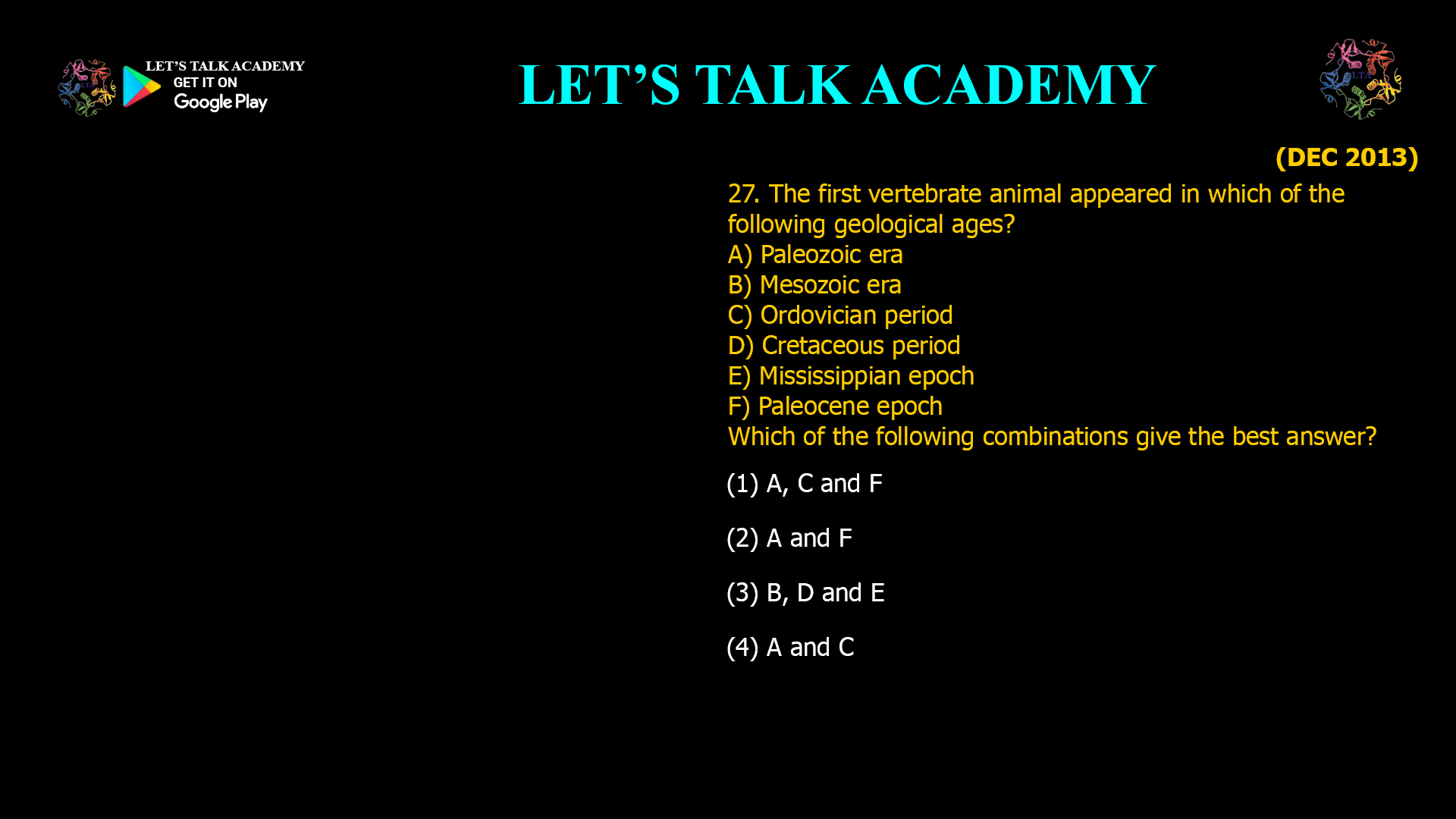- The first vertebrate animal appeared in which of the following geological ages?
A) Paleozoic era
B) Mesozoic era
C) Ordovician period
D) Cretaceous period
E) Mississippian epoch
F) Paleocene epoch
Which of the following combinations give the best answer?
(1) A, C and F (2) A and F
(3) B, D and E (4) A and C
When Did the First Vertebrate Animals Appear? Unveiling the Paleozoic Origins
The story of life on Earth is a tale of dramatic transformations, and the emergence of vertebrates stands as one of the most pivotal evolutionary milestones. But when exactly did the first vertebrate animals appear? To answer this question, we must journey deep into the geological past, examining the eras and periods that shaped the earliest backboned creatures.
Understanding Geological Time: Eras, Periods, and Epochs
Earth’s history is divided into a hierarchy of time intervals: eras, subdivided into periods, and further into epochs. For the evolution of vertebrates, the most significant of these is the Paleozoic Era, a time of immense biological innovation that began around 541 million years ago and ended about 252 million years ago.
The Paleozoic Era: Cradle of Vertebrate Evolution
The Paleozoic Era is often called the “Age of Ancient Life.” It witnessed the explosion of multicellular organisms, the colonization of land, and, crucially, the rise of the first vertebrate animals. This era is divided into several periods, including the Cambrian, Ordovician, Silurian, Devonian, Carboniferous (subdivided into Mississippian and Pennsylvanian epochs), and Permian.
The Cambrian Explosion: The First Steps
The Cambrian Period (541–485 million years ago) saw a rapid diversification of life known as the Cambrian Explosion. During this time, the earliest chordates—animals with a notochord—appeared. Some of these chordates, such as Haikouichthys and Myllokunmingia, are considered among the earliest vertebrates. These tiny, fish-like creatures possessed primitive backbones and are known from fossil deposits in China dating back over 520 million years.
Ordovician Period: The First Definitive Vertebrates
While the Cambrian gave rise to the earliest vertebrate-like animals, it was in the Ordovician Period (485–444 million years ago) that the first definitive vertebrates flourished. Fossil evidence from this period includes armored jawless fish, such as conodonts and ostracoderms, which are recognized as true vertebrates. These animals represent the first clear step in the evolutionary lineage that would eventually lead to fish, amphibians, reptiles, birds, and mammals.
Why Not the Mesozoic, Cretaceous, or Later Epochs?
It’s a common misconception to associate the origins of vertebrates with the Mesozoic Era—the age of dinosaurs—or with later periods like the Cretaceous or epochs such as the Paleocene. In reality, by the time these later intervals arrived, vertebrates had already diversified into a vast array of forms, including fish, amphibians, reptiles, and early mammals. The true origin of vertebrates is rooted much deeper in time.
The Mississippian Epoch: A Time of Diversification, Not Origin
The Mississippian Epoch (359–323 million years ago) is part of the Carboniferous Period and is notable for the diversification of amphibians and the first appearance of reptiles. However, vertebrates had already existed for hundreds of millions of years by this point.
The Best Answer: Paleozoic Era and Ordovician Period
Given the options, the best combination that marks the appearance of the first vertebrate animals is:
A) Paleozoic Era
C) Ordovician Period
This combination is supported by fossil evidence and the consensus of paleontological research. The Paleozoic Era provides the broad timeframe, while the Ordovician Period pinpoints the specific interval when vertebrates became a prominent part of Earth’s ecosystems.
The Evolutionary Significance of Early Vertebrates
The emergence of vertebrates transformed the trajectory of life on Earth. These early animals developed key features that would pave the way for complex body structures and advanced nervous systems. Over time, vertebrates evolved jaws, limbs, and lungs, enabling them to conquer new environments and diversify into the myriad forms we see today.
Key Innovations of Early Vertebrates:
-
Backbone (Vertebral Column): Provided structural support and protection for the nervous system.
-
Cranium (Skull): Shielded the brain and sensory organs.
-
Paired Fins: Allowed for improved mobility in aquatic environments.
-
Jaw Development: Evolved later, enabling more efficient feeding strategies.
Fossil Evidence: Unlocking the Past
Fossils of early vertebrates, such as conodonts and ostracoderms, are found in Ordovician rock layers around the world. These fossils reveal a gradual transition from simple, jawless fish to more complex vertebrates with bony skeletons and jaws. The study of these ancient remains provides invaluable insights into the evolutionary steps that led to the vertebrate dominance of today’s animal kingdom.
Why Accuracy Matters in Science Communication
Understanding when vertebrates first appeared is not just a matter of academic curiosity. It shapes our knowledge of evolution, biodiversity, and the interconnectedness of life. Accurately portraying these milestones helps educators, filmmakers, and enthusiasts foster a deeper appreciation for the natural world and its history.
Conclusion: The Dawn of Vertebrates
The first vertebrate animals appeared during the Paleozoic Era, specifically in the Ordovician Period. This epochal event set the stage for the incredible diversity of vertebrate life that would follow. By recognizing the true origins of vertebrates, we honor the complexity and wonder of Earth’s evolutionary story.



